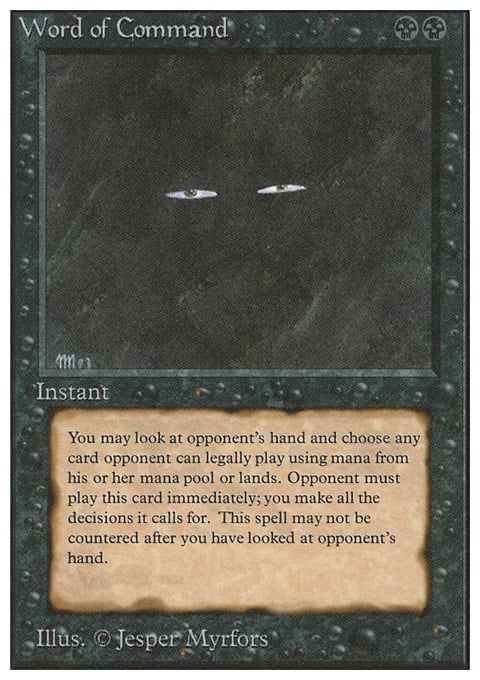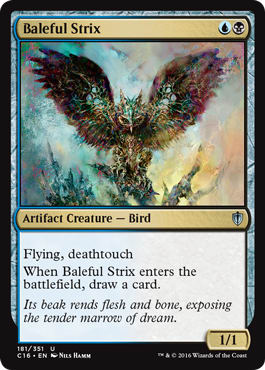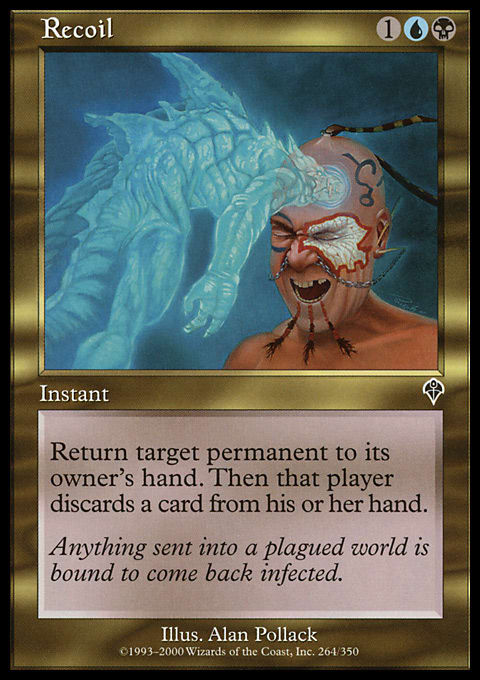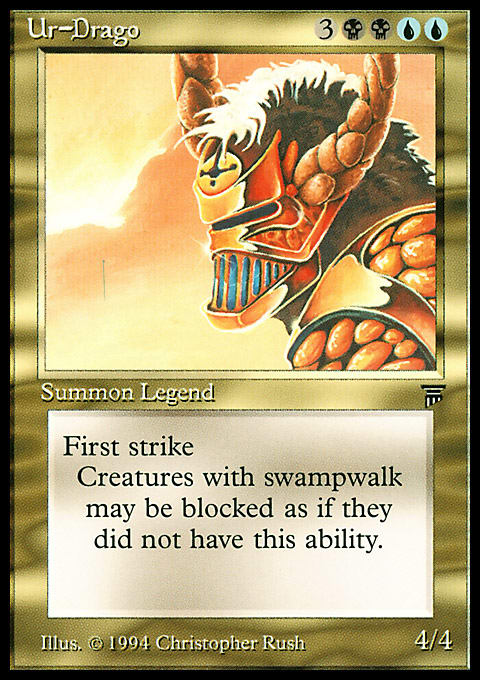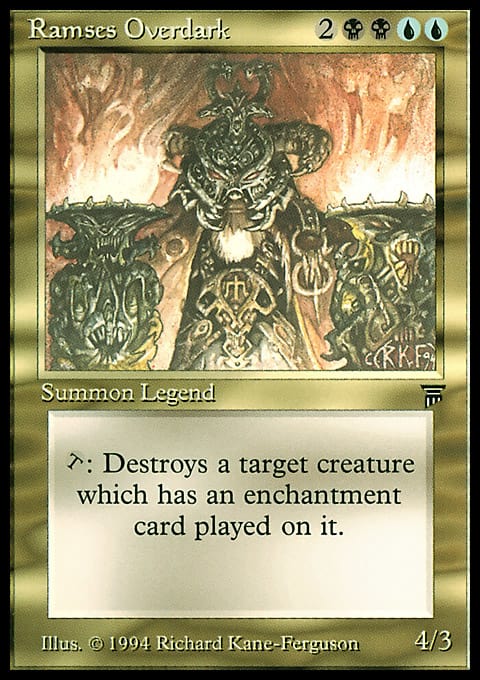Welcome back! Ravnica can be a confusing place for the uninitiated, so last year, I did a series of preview articles on how each of the Return to Ravnica guilds was going to affect the Commander community. With Gatecrash coming out on January 26, it’s time to go back to the mean streets, alleys, and sewers of Ravnica!
As before, I’ll explore the allied color pairs first (Dimir this week and Gruul next), followed by the opposing pairs (Boros, Orzhov, and finally Simic). Each week, I’ll run down some of the strengths and weaknesses of each color pair, uncover a few hidden gems that each guild has to offer, and rank the commanders that we can choose from. I’ll finish each column with some directions you might want to take when building your first deck in each guild.
Strengths
Dimir is far and away the most power-hungry guild. If you aspire toward absolute dominance over your opponents, you’ve come to the right place!
- Knowledge is power – Dimir is the guild of secrets, manipulating knowledge to their own benefit (of course—Dimir doesn’t do anything for anyone else’s benefit!). Mechanically, this means damaging your opponents’ minds (discard and capping) and memory (milling) while building your own mental capabilities through tutoring (including the wonderful transmute mechanic), card-draw, and deck manipulation. Card advantage and card quality are not determinative in multiplayer, but they go a long way toward earning you the win, and Dimir are the masters of it.
- Power is power – It’s not surprising that I have a Cersei Lannister quote here, as she exemplifies the Dimir philosophy in a lot of ways. Dimir has the ability to control pretty much any part of the game, and the guild is perhaps second only to Azorius in terms of how easily it leads you toward building a control deck. Neither black nor blue can technically destroy artifacts and enchantments, but between countering, killing, bouncing, killing, stealing, killing, capping, and killing, they are capable of dealing with pretty much anything when they combine forces. The synergy between blue’s bounce and black’s discard is particularly potent, which is part of the reason Honden of Seeing Winds and Honden of Night's Reach are the only cards in the Honden cycle that I play—but I love playing them together. Bounce spells such as Capsize, Tradewind Rider, and Kiri-Onna go incredibly well with repeatable discard, allowing Dimir decks to flip the bird at the color pie.
- Master of puppets – In the beginning, there was Control Magic and Animate Dead . . . and also Word of Command. The first two have seen many variants over the years (Volition Reins, Blatant Thievery, and Beacon of Unrest being favorites), giving Dimir an unrivaled ability to play with opponents’ toys. Word of Command is a slightly different take on the same theme that allows you to play a card from your opponent’s hand. They let that mechanic lie fallow for years before finally trying various versions, starting (I believe) with Spelljack in Judgment. Most of these cards are in Dimir territory, as we shall see.
- Ninjas – ’Nuff said.
Weaknesses
Dimir sometimes feels like a color combination that can do anything, but that’s not entirely true. Neither color can actively get rid of enchantments and artifacts, as I’ve discussed, and they don’t ramp worth a damn. The easiest solution is to become reliant on artifact mana—and blue has, shall we say, an affinity for artifacts—but this leads to a vulnerability to sweepers. There’s nothing worse than planning your game around a Thran Dynamo only to be crippled when it’s blown away and you can't repair your mana base in time.
The most important thing in playing Dimir is to never, ever, miss a land drop. As good as Sol Ring, Mana Vault, and so on can be, I've found myself leaning more and more on cards like Walking Atlas, Armillary Sphere, and even Mycosynth Wellspring. You’ll draw a lot of cards in these colors, and if you can just keep making your land drops in the early turns until your card-advantage engines come online, you’ll probably be fine.
Hidden Gems
Baleful Strix – I you’re like I am, you tore open the Planechase precon decks and went straight to the rares. Fortunately, my friends are smarter than I am, and I was soundly beaten until I started playing with the Strix. It really is a fantastic card. Paying 3 mana for a chump-blocking Pilgrim's Eye has saved me from a lot of damage in the early stages of many games, but Baleful Strix is cheaper, a far better rattlesnake, and home to a much more relevant enters-the-battlefield (ETB) ability in the mid- to late-game. Sure, it’s currently a $13 card, but I know some of you have these lying around in forgotten corners of your collections.
Barrin's Spite – This isn't quite a two-for-one, as only one of the creatures you target is going away permanently, but it frequently gives you a big boost in tempo.
Cavern Harpy – Creatures with ETB abilities are clutch in multiplayer, where resource management is key. Cavern Harpy is a major force multiplier in any deck that relies on ETB effects, and the life payment makes her reusable and a versatile defender.
Cemetery Puca – Unlike a regular Clone, Cemetery Puca has no synergy with ETB creatures and deals very poorly with your opponents’ commanders (it can’t trigger the legend rule like a normal Clone-ikaze, and when a commander goes to the command zone, it doesn’t actually die, so the Puca can't copy it). Even so, it deserves to be played a lot more than it is; creatures routinely hit the bin, and being able to copy the best of them on an ongoing basis is definitely worth a deck slot.
Dimir Doppelganger – Thanks to Abe Sargent for turning me on to this one! I’m not quite sure if this should be classified with blue’s Clone effects or black’s graveyard-hate effects; Dimir Doppelganger is a repeatable Clone effect for dead critters, although once you’ve copied something, you usually can’t copy it again, but it is also graveyard removal for critters. There will be times when Dimir Doppelganger can snatch an Ulamog, the Infinite Gyre or Kozilek, Butcher of Truth from the graveyard and ride it all the way to victory, but there will be other times when you either can’t or don’t want to use your Doppelganger to get rid of a smaller critter because it means virtually losing the creature you're currently copying.
My advice is to get your hands on a play set of Dimir Doppelganger and decide for yourself whether it is a better fit for your deck and metagame than the more commonly played Nezumi Graverobber, Body Double, or Puppeteer Clique. I think you’ll enjoy playing around the limitations and advantages of this card.
Dire Undercurrents – My play style is all about grinding attrition, and few cards are better for the long game than this. Keep your hand full-to-overflowing while your opponents live in a permanent state of top-deck. It works well with Ninjas, but if you’re really mean, consider pairing this with that shiny Oona, Queen of the Fae that you picked up in From the Vault: Legends.
Memory Plunder – One of the more flexible Word of Command variants, this allows you to take your pick of the instants and sorceries in your opponents’ graveyards at instant speed. You don’t need me to tell you that responding to a lethal attack with someone else’s Planar Cleansing is good, but I’ll tell you anyway: It’s good! Not to mention it’s extraordinarily funny when the sweeper belongs to the same opponent as the attacking creatures.
Mindleech Mass – The recently printed Silent-Blade Oni is a fearsome killing machine, but Ravnica’s original Mindleech Mass deserves some love, too. Trample isn't often found in these colors, but the Mass is the king of saboteurs, and he always connects.
Recoil – One of my favorite pieces of spot removal, Recoil hits anything, in colors that struggle to deal with noncreature permanents. It doesn’t usually get rid of things permanently, but the ability to get rid of anything any time, without the card disadvantage of other bounce spells, makes it well worthwhile. River's Grasp deserves a mention here, too—it only bounces creatures, but the discard is your choice, and you can hit a different player if necessary.
Spinal Embrace – This one is an Alongi favorite, and I’ve been playing with it for years. You tree-huggers can keep your Giant Growth; this is a truly game-changing combat trick. Whether it’s an Ulamog or a 45/45 Kresh the Bloodbraided, Spinal Embrace gets rid of any troublesome creature, usually provides a two-for-one, and gains you some life into the bargain. Power, flexibility, and resource advantage are what Dimir is all about!
Twisted Justice – The original Diabolic Edict cost 2 mana, and most of the many variants we’ve seen since have been in the 2- to 4-mana range. Twisted Justice is the most expensive member of the Edict family, but it can be so backbreaking that it sometimes seems like a bargain. I’ve had some games in which I cast it right on schedule on turn six and nailed my opponent’s commander as soon as he played it. In other games, I’ve been able to sweep away most of my opponent’s creatures and then drop Twisted Justice to remove the fatty that he had been holding in reserve. As Overwhelming Intellect is to Counterspell, Twisted Justice is to the humble Edict.
Meet the Boss
Crap
If you weren't playing during the earliest days of Magic, don’t feel too bad; there was much more crap in those early sets than unfettered awesomeness, and Dimir really got the short end of the stick!
Ur-Drago – Kicking off the Legends-era suckfest is Ur-Drago, the answer to a question that you never asked. Despite the occasional Mire Boa, swampwalk is something that black mages excel at (see below), so this is not only lame and overcosted, but actually counter-productive.
Princess Lucrezia – I’m all for playing expensive spells in Commander, but if you’re really that desperate to make it to 7 mana, just play more lands.
Riven Turnbull – Better than Princess Lucrezia only because he produces black mana.
Ramirez DePietro – Because Pirates are cool.
Sivitri Scarzam – Because Craw Wurm is undercosted.
Nebuchadnezzar – Love the art; intrigued by the mechanics; despair at the power level. There might be some combo here with Sunder, as you can name any card including land, but old Neb is pretty limited. Play him for the RKF style points or if one opponent is always tutoring up the same old predictable cards. Otherwise, you can do better.
Skeleton Ship – Anything that can only affect one creature per turn and doesn’t necessarily kill anything is going to struggle to affect the board in multiplayer. If it were a 4/4 (a la Havengul Lich), it might be a different story, but at best, this is flavorful crap, or perhaps semi-playable, anti-persist technology.
Fair to Middlin’
Ramses Overdark – A wannabe Johnny card, Ramses doesn’t quite offer enough power to justify building around him. You can still do it and have fun (I’d start with False Demise, Fool's Demise, and Unhallowed Pact), but in terms of sheer power, he isn't taking the world by storm. Cool name, though!
Sygg, River Cutthroat – Dark Sygg is probably less powerful than his Azorius counterpart, but he is much more flexible. You can put him in any aggro or Voltron deck (not just Merfolk tribal) and use his draw ability to avoid overextending or just to benefit from the damage your opponents receive. Of course, your opponents may be a little bit reluctant to let you draw cards, but the occasional Koskun Falls, No Mercy, or Dissipation Field will keep their dudes pointed away from you, and if necessary, Angel's Trumpet, Bullwhip, and various Nettling Imp effects can keep the blood (and the cards!) flowing at an acceptable rate. Don’t forget the shadow mechanic from Tempest block!
Wydwen, the Biting Gale – A flying, blinking Hill Giant is rarely great, but it is also never bad. In a long game (and Dimir excels at the long game!), you might be down a few life from returning her to your hand, but you will also be the only one at the table who can still afford to cast his commander.
Circu, Dimir Lobotomist – This is the difference between a truly Johnnyable card and one that is just fair-to-middlin’: You can put Circu in a mill deck (and I’ve been tempted for a couple of years now), but that isn't enough to give it a major leap in power. He’s a good creature, but he’ll only add one or two cards per turn to your milling potential. Obviously, his ability is neutered in a singleton format, although he may be able to keep people from playing their staples if you’re lucky.
Just Johnnyable
Dralnu, Lich Lord – You generate less value out of his recursion ability in multiplayer than you do in a duel because merely casting the same spell twice is less impressive against three or more opponents. And as the game goes long, the chances that Dralnu will be exposed to damage in one form or another is pretty high. That’s why he has to be built around—anything from Lightning Greaves to Bubble Matrix can work, although I also suggest lots and lots of sacrifice outlets—just to be on the safe side.
That being said, my buddy Tony has a tribal Zombie deck with Dralnu at the helm, and he made me a believer in the Lich Lord’s power. Having access to any card in your graveyard can give you a tremendous advantage, especially when everyone else is living off the top. Plus, that art is some of the awesomest in the entire game, dripping with flavor, badassness and—let’s be honest—raw sex appeal.
Powerhouses
Szadek, Lord of Secrets – Szadek is the king of milling. Of course, if you can deal 80 power worth of milling, you could more easily deal 21 commander damage with another legend, but in Casual Land, it isn’t about the easiest path to victory. Try a Szadek build that has absolutely no ways to deal damage, just for the degree of difficulty . . . or make it look as though that’s what you’re doing and then burn out the last opponent with Rite of Consumption on a 40/40 Szadek. It’ll be great fun either way!
Grimgrin, Corpse-Born – As a longtime player of Thraximundar, I understand the value of repeatable removal on an ever-growing threat. Grimgrin has a pretty serious downside, but any deck should be able to deal with it, and just a handful of cards can be enough to turn him into a hulking, flesh-dripping machine-gun. Also, Gravecrawler is a thing.
Vela the Night-Clad – Two things make Vela sing: All your dudes get intimidate, and all your opponents lose life when your dudes die. I loves me some “all”! Unless you’re playing creatureless, Vela is probably going to add value to any deck. Feel free to build around her, but don’t think that you have to.
Wrexial, the Risen Deep – A 5/8 is ridiculously durable, and any commander with two different types of landwalk is a threat to go the distance; a lot of people play Islands, and everyone plays Swamps. Wrexial is one of those high-variance commanders because the spells that you are able to cast with him will be completely different from game to game. This is generally a lot of fun, although you will have the occasional game like the one I had recently, in which your three opponents are a creature-only Momir Vig, Simic Visionary deck, an artifact-heavy Gisela, Blade of Goldnight deck, and a highly thematic Angel deck. Between multiple swings with Wrexial and casting Chancellor of the Spires two or three times, I was able to copy two Beast Within and a Naturalize. I hope you have better luck than I had . . . but then, practically everyone does!
Oona, Queen of the Fae – Big fat body? Check—although I think she prefers to be called “voluptuous.” Makes her own army? Check. Takes away your opponents’ weapons? Check. Alternate win condition? Check. Oona is among those rare cards (Geth, Lord of the Vault is the other example that springs to mind) that you can ride all the way to the win in any game; as long as she’s on the board, you don’t really need to spend your mana on anything else, and even after she’s gone, your opponents will be so busy dealing with the army of flyers she created that you’ll probably have a chance to cast her again. She’s absolutely one of the strongest commanders in the game.
Dimir Dimensions
I've said it before and I’ll say it again: Life moves pretty . . . no, I mean multiplayer is all about resource management, and Dimir is one of the best color pairings in the game for building your resource base. That means that you can do pretty well just by shuffling some random blue and black cards together and calling it a deck. On the other hand, if you want to have more of a focus, here are some ways to take advantage of the strengths and synergies that Dimir has to offer.
Hand control – Discard with Honden of Night's Reach and Honden of Seeing Winds, Urza's Guilt, Specter effects such as Dimir Cutpurse, Blizzard Specter, and Doomsday Specter, plus as much bounce as you can find. Specialty cards like Breathstealer's Crypt can make your opponents discard creatures even before they join them, which gets you more value out of cards like Megrim and Geth's Grimoire and makes targeted discard like Nebuchadnezzar and Cabal Therapy that much more effective.
Milling – The first time we visited Ravnica, Dimir had a fairly substantial milling theme, headlined by Szadek and Circu as well as cards like Glimpse the Unthinkable and Psychic Drain. Lorwyn/Shadowmoor gave us even more goodness (I have a sixty-card Drowner of Secrets deck and another sixty-card deck built around Drowner Initiate and Memory Sluice), but Magic’s history is filled with strong blue mill cards. And if your commander is Vela the Night-Clad, you should seriously consider Raven Guild Master!
Reanimator – Building a straight reanimator deck is really tough; you need to combine three types of cards—fatties, reanimators, and cards that put fatties in your graveyard—and if you don’t include the right mix of them, they're useless. Enter blue, with its card filtering and looting effects, which are the perfect ways to dump big dudes into the ’yard and make sure you have a handful of reanimation spells. U/B reanimator decks tend to be much stronger and more resilient than mono-black builds.
And finally, if reanimating your own critters isn't getting it done for you any more, how about reusing everyone’s spells? Here is the list for my Wrexial deck. It started out as a very dedicated Cthulhu theme deck, and as a result, most of the support cards are unusual and/or relatively low-powered (this is not your typical Dimir deck), but it’s a lot of fun to play, with high variance, challenging decisions, and a ton of potential power. Enjoy!
Dimirthulu - Commander | Daryl Bockett
- Commander (0)
- Creatures (25)
- 1 Abyssal Gatekeeper
- 1 Artisan of Kozilek
- 1 Augury Owl
- 1 Avatar of Woe
- 1 Callous Oppressor
- 1 Chancellor of the Spires
- 1 Dimir Doppelganger
- 1 Faceless Butcher
- 1 Guard Gomazoa
- 1 Harvester of Souls
- 1 Havengul Lich
- 1 Liliana's Shade
- 1 Magus of the Jar
- 1 Mindleech Mass
- 1 Nekrataal
- 1 Nevermaker
- 1 Nezumi Graverobber
- 1 Puppeteer Clique
- 1 Silent-Blade Oni
- 1 Twisted Abomination
- 1 Phyrexian Metamorph
- 1 Aboshan, Cephalid Emperor
- 1 Ashling, the Extinguisher
- 1 Ink-Eyes, Servant of Oni
- 1 Sygg, River Cutthroat
- Spells (33)
- 1 Betrayal of Flesh
- 1 Capsize
- 1 Clutch of the Undercity
- 1 Consume the Meek
- 1 Counterlash
- 1 Hero's Demise
- 1 Memory Plunder
- 1 Psychic Spiral
- 1 Rend Flesh
- 1 Spell Burst
- 1 Spinal Embrace
- 1 Terror
- 1 Barter in Blood
- 1 Brainspoil
- 1 Innocent Blood
- 1 Reanimate
- 1 Rite of Replication
- 1 Spelltwine
- 1 Twisted Justice
- 1 Knowledge Exploitation
- 1 Dire Undercurrents
- 1 Honden of Night's Reach
- 1 Honden of Seeing Winds
- 1 Altar of Dementia
- 1 Echo Chamber
- 1 Grindstone
- 1 Grinning Totem
- 1 Mind's Eye
- 1 Planar Portal
- 1 Sword of Body and Mind
- 1 Trepanation Blade
- 1 Whetstone
- 1 Grimoire of the Dead
- 2 Mana Rocks (4)
- 2 Mana Rocks]
- 1 Dimir Signet
- 1 Gilded Lotus
- Lands (39)
- 1 Desert
- 1 Duskmantle, House of Shadow
- 1 Halimar Depths
- 1 Nephalia Drownyard
- 1 Quicksand
- 1 Vesuva
- 1 Urborg, Tomb of Yawgmoth
- 32 Mana Lands













